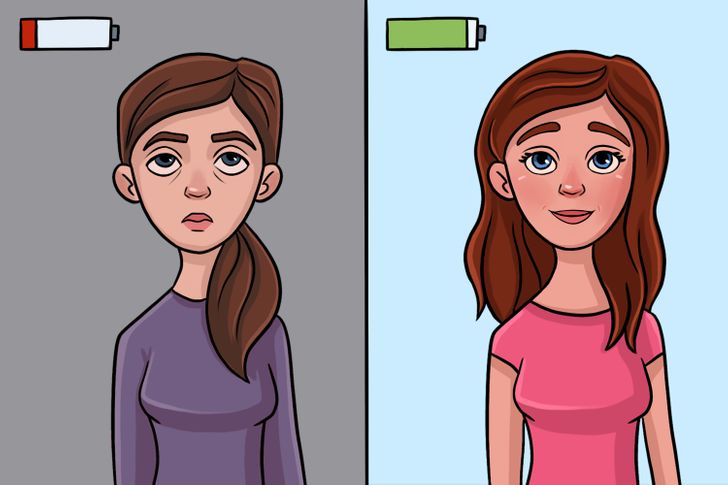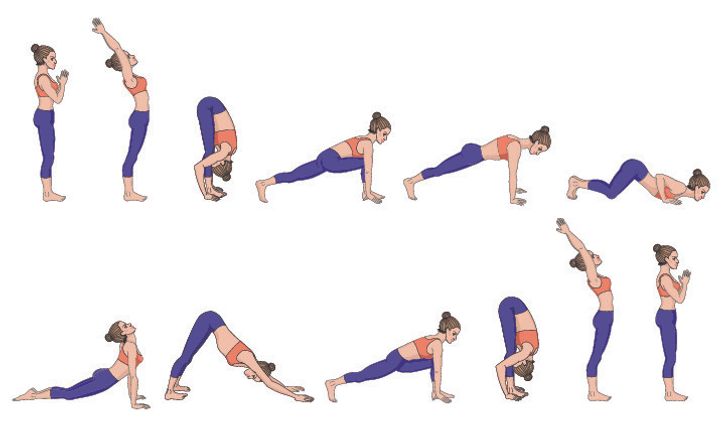1. Improves overall health and increases energy levels.
[raw_html_snippet id=”top-responsive”]

Your mental and physical health will improve as a result of your regular practice of sun salutations, which adds value to every part of your life. According to studies, it lessens the effects of stress on you and the stress itself. It is a salutation to the very source of all energy on Earth; thus, naturally, doing so will make you feel more energized and in tune with the world around you.
This is how to do a Sun Salutation.

This is how to move from left to right through the 12 steps of a Sun Salutation, as shown in the picture above.
For Pranamasana or the prayer pose, stand with your feet a little bit apart. Fold your hands in Namaste and bring them to your chest. Bow your head. Take calm breaths in and out.
Hastauttanasana: Take a deep breath in and raise your hands above your head. Make sure your ears stay in the middle of your arms as you do this. You should lean back and pull your stomach in. For 10–15 seconds, hold the pose and your breath.
Padahastasana is a standing forward bend. As you exhale, bend forward and lengthen your back. Touch your toes and put your palms flat on the floor if you can go lower. Keep your knees straight. Try to go as far as you can without bending your knees.
Ashwasanchalasana: Inhale and lift your left leg back while keeping your hands on the floor. Put your toes and knee on the floor and bend your right knee simultaneously. Keep your upper body straight. It would be best if you had your right knee between your arms. As you exhale and roll your eyes up toward the sun, look as far up as possible.
Plank pose (Kumbhakasana): Inhale, move your right leg back, and raise your left knee so that it is parallel to your right knee. Keep your toes on the ground. While keeping your hands flat on the ground, lower your hips and back. With your arms straight, your body will look like a table or plank parallel to the ground. Exhale.
[raw_html_snippet id=”top-responsive”]
Ashtanga Namaskar (eight-point salutation): Take a deep breath in and bend your elbows while lowering your knees to the ground. Touch your chin and chest to the ground as you let out your breath. The stomach and abs need to be pulled in and held to keep from touching the floor.
Bhujangasana, or “cobra pose,” is done by taking a deep breath in and moving forward while lifting your spine and then straightening your arms. Keep your feet flat on the ground and your legs in line with your pelvis. Make sure you don’t slump your shoulders.
Downward dog pose: Let your breath out and lift your body from the hips. Move your feet to lie flat on the ground with your knees straight. As you look down, your spine should be long, and your body should look like a mountain peak, with the hips at the top.
Ashwasanchalasana (equestrian pose): Take a deep breath and return to the pose. Be sure that the leg on the other side goes back. Now, your left leg should be in front, and your right leg should be behind you, just like in step 4.
Padahastasana (standing forward bend): Exhale and bring your right leg forward, straightening both legs to stand while keeping your front body bent down and your palms flat on the ground or touching your toes.
Hastauttasana (standing backbend): Take a deep breath and straighten your upper body while keeping your spine long. Bring your arms up above your head and place your ears in the middle of them. Hold this position for 10–15 seconds.
Pranamasana: Take a deep breath out and come forward while straightening your back. Step 1 is to bring your arms down into the Namaste pose.